3 Oceania
The Pacific Island countries are Japan’s “neighbors” bound by the Pacific Ocean and also share deep historical ties with Japan. Also, in possessing vast Exclusive Economic Zones (EEZ), Note 13 these countries are key to maritime transport activities and provide essential fishing grounds for bonito and tuna fisheries.
Meanwhile, many Pacific Island countries are relatively new independent states with the urgent task of becoming economically independent. In addition, they face common challenges particular to small island countries, such as small-scale economies dependent on primary industry, territories geographically extended over the vast area of the sea, difficulty in accessing international markets, and vulnerability to natural hazards.
● Japan’s Efforts

Parliamentary Vice-Minister for Foreign Affairs Miyake attends the third Japan-PIC Economic Forum held as a PALM9-related event (November 2021)
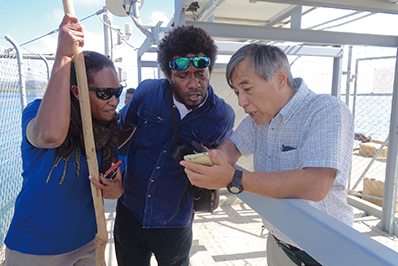
Checking images of Tsunami Watch Cameras after their installation as part of the “Project for Enhancing the Capacity of Issuing Earthquake, Tsunami and Storm Surge Information,” a technical cooperation project currently underway in Vanuatu (Photo: JICA)
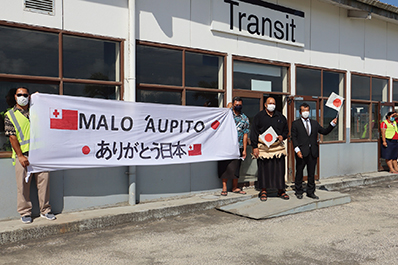
Prime Minister Hu’akavameiliku (center) welcoming the Self-Defense Forces (SDF) plane arriving at the airport in Tonga to transport emergency relief goods (January 2022)
In order for Pacific Island countries to achieve political stability and self-reliant economic development, it is crucial not only to support each country in overcoming their socio-economic vulnerabilities, but also to provide comprehensive assistance for the region. In addition to promoting cooperation with the Pacific Islands Forum (PIF), Note 14 a framework for regional cooperation composed of Pacific Island countries, Japan has hosted the Pacific Islands Leaders Meeting (PALM), a summit meeting between Japan and Pacific Island countries every three years since 1997. Note 15
In July 2021, PALM9 was held via video conference and the leaders discussed the five priority areas for the next three years: (i) COVID-19 Response and Recovery, (ii) Sustainable Oceans based on the Rule of Law, (iii) Climate Change and Disaster Resilience, (iv) Strengthening Foundation for Sustainable and Resilient Economic Development, and (v) People-to-People Exchanges and Human Resource Development. The Leaders Declaration and annexed documents “Joint Action Plan for Strengthening Pacific Bonds and for Mutual Prosperity,” etc., were adopted as an outcome of the discussions (see also “ODA Topics 6”).
In June 2021, the Interagency Committee for the Promotion of Cooperation with Pacific Island Countries determined the basic policy of reinforcing and concentrating resources for Pacific Island countries and strengthening initiatives with all-Japan efforts.
In response to the spread of COVID-19, Japan provided approximately 320,000 doses of vaccines manufactured in Japan to Fiji, Kiribati, Samoa, Solomon Islands and Tonga through the COVAX Facility Note 16 by the end of 2021. Throughout the Oceania region, Japan also contributes to the strengthening of health and medical systems by providing health and medical equipment, developing cold chains Note 17 to deliver vaccines to vaccination sites, and securing medical personnel to administer the vaccinations. Furthermore, to support economic recovery, Japan has provided COVID-19 Crisis Response Emergency Support Loans totaling ¥42.5 billion to Fiji, Papua New Guinea, and Solomon Islands.
Moreover, in view of the humanitarian perspective and friendly relations with Tonga, which was affected by the volcanic eruption and tsunami that occurred on January 15, 2022, Japan provided emergency relief goods through JICA and dispatched the Japan Disaster Relief (JDR) Self-Defense Force (SDF) Unit to transport the goods. Furthermore, Japan decided to provide emergency grant aid of approximately $2.44 million to Tonga.
Japan will continue to support Pacific Island countries in strengthening health and medical systems, recovering the economies impacted by COVID-19, and providing assistance for emergencies, including for disasters, in collaboration with the United States, Australia, New Zealand, and other partners. Through such efforts, Japan will work hand in hand with the region in building a resilient, stable, and prosperous Oceania region toward the post-COVID-19 era (see “ODA Topics 2” for information on efforts to realize a “Free and Open Indo-Pacific (FOIP)”; see “Project Introduction Column” below for Health Promoting Village Project for Solomon Islands).
Solomon Islands
Health Promoting Village Project
Technical Cooperation Project (June 2016 – June 2021)
In the Solomon Islands, people traditionally lived self-sufficiently, but in recent years, imported products have been brought in, which has changed their dietary habits greatly. For this reason, lifestyle-related diseases have rapidly increased and currently account for more than 60% of deaths.
In response to this situation, Japan has focused on the prevention of under-nutrition and lifestyle-related diseases, along with long time challenges, including malaria countermeasures, the water problems, and the improvement of hygiene and sanitation conditions, and has worked on strengthening health services, formulating policies, and developing health volunteers in villages, among other efforts, in Guadalcanal and Makira-Ulawa Provinces. Moreover, Japan has provided support for turning the mechanism under which residents tackle their own health improvement (the health promoting village model) into a national system.
Steady activities were carried out, such as raising the health awareness of the residents by conducting their physical measurements and indicating their BMI,*1 and having health volunteers explain lifestyle-related diseases and the three major nutrients while showing the residents actual food ingredients. As a result, knowledge about lifestyle-related diseases among the residents in the targeted villages improved, resulting in a decrease in the proportion of infants with stunted growth*2 (from 25.5% to 22.8%) and a fall in the mean blood glucose level among the residents (from 6.55 mmol/L to 6.22 mmol/L) compared to the values before the project was implemented.
Moreover, the problem of garbage arising from increasing consumption of processed food products was worsening in the villages, and village cleaning activities were regularly carried out led by the health volunteers. As a result, the hygiene and sanitation conditions in the villages improved, and secondary effects were also seen such as with the reduced numbers of mosquitos contributing to malaria control, and the health awareness of the residents themselves improved. Prime Minister Sogavare mentioned and highly praised the specific outcomes of this project in a policy speech.
Currently, the National Healthy Settings Coordinating Committee established through this project is leading the rollout of the health promoting village model to other provinces. In this way, Japan’s efforts have taken root in communities, and it is hoped that activities for a better environment and health conditions will continue.
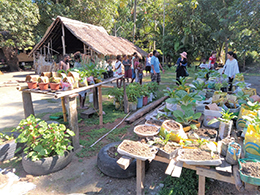
New home vegetable gardens to increase the intake of fruit and vegetables (Photo: JICA)
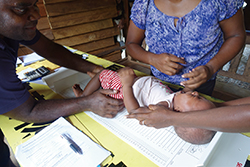
Measuring a child’s height (Photo: JICA)
*1 An index that indicates the degree of obesity.
*2 A state when a child falls into chronic malnutrition and does not grow to the height appropriate for his/her age because he/she is not able to get enough daily food or nutrition.
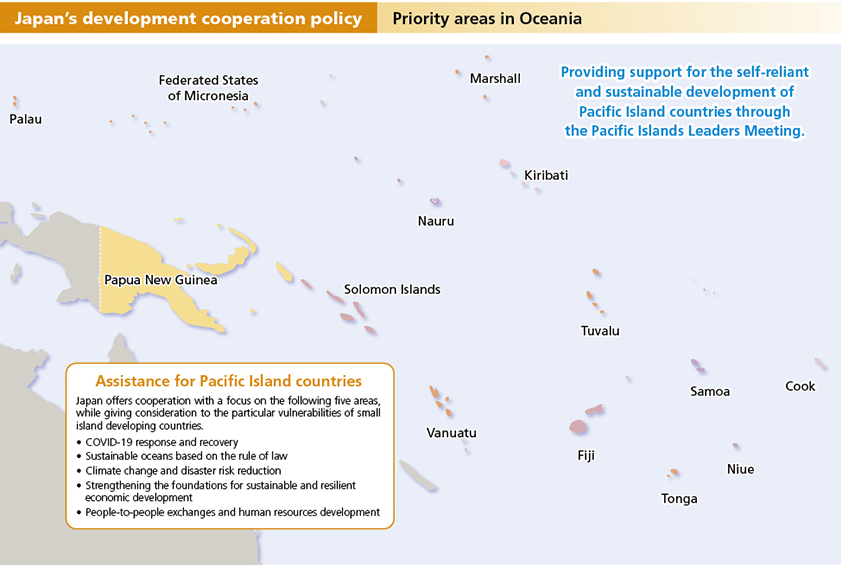
- Note 13: Maritime zones where a sovereign country has certain economic rights that can be established outside its territorial waters.
- Note 14: The 16 PIF member countries and two member regions are Australia, New Zealand, Papua New Guinea, Fiji, Samoa, Solomon Islands, Vanuatu, Tonga, Nauru, Kiribati, Tuvalu, Federated States of Micronesia, Marshall, Palau, Cook, Niue, French Polynesia, and New Caledonia.
- Note 15: The PALM Ministerial Interim Meeting has been held approximately 18 months after each PALM with foreign ministers serving as co-chairs since 2010.
- Note 16: See the glossary.
- Note 17: See Note 2.
